How Chelsea beat the low block: Frank Lampard has devised clever way to beat defensive teams without being hit on the counter

An early season hammering by Manchester United raised a few concerns about the way Chelsea play, over-committing in attack at the expense of defensive stability, but with the club sat in second place in the table before Liverpool vs Manchester City, something is clearly working.
Frank Lampard’s Chelsea are getting results by playing entertaining football and opposition teams are so concerned about this they sit deep against them to prevent being opened up by slick forward play. It’s a conundrum Liverpool and Manchester City often encounter - how to beat a defending team sat in a compact block without being hit on the counter.
Roy Hodgson opted for exactly this highly defensive setup in Crystal Palace’s 2-0 defeat on Saturday. By staying compact in a low block, Palace’s plan was to frustrate and tease Chelsea into sending players forward in an attempt to gain numerical superiority, leaving spaces to exploit on the counter as a result. It worked well in the first half, with Chelsea limited to few chances.
“We’ve had a few teams come here who are tough to break down and it is a test,” said Lampard after the match. “It’s about how do you break them down with the ball at your feet, it’s also switching on not to get hit with the sucker punch. Palace are absolutely setup to do that with Andros [Townsend] and Zaha.”
However, Lampard appears to have devised a clever way to overcome this problem - overloading the wide areas.
Although nominally a 4-2-3-1, Lampard’s team attack in a front four with the forwards covering each others’ positions to keep a diamond shape in attack. Christian Pulisic, Mason Mount, Tammy Abraham and Willian did this throughout, and it’s no coincidence that the majority of Chelsea’s play came down the left where the electric Pulisic was positioned. 39 per cent of Chelsea’s attacks were focused on this side.
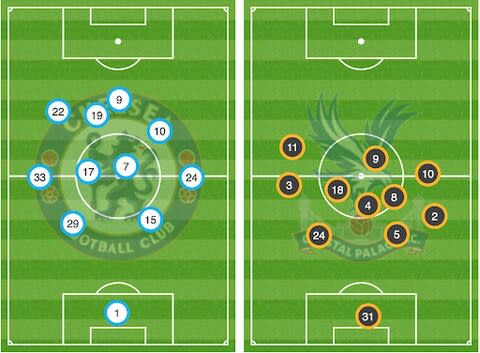
For the first goal, Kovacic and N’Golo Kante both were both in the left half-space behind the front four. Emerson is wide left and Reece James right but the sheer number of bodies in the final third means Palace’s attackers must drop back to help, limiting their ability to counter.
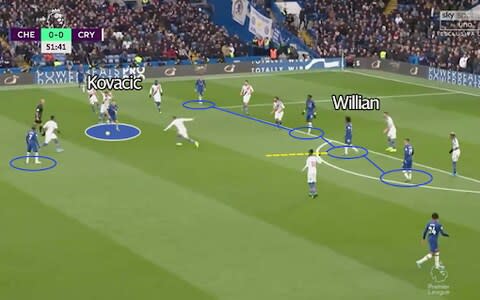
Fluid movement off the ball ensured Chelsea maintained a forward diamond shape throughout and by positioning themselves in a four across the Palace defence, they kept every Palace defender busy.
The yellow line above is the run Willian makes to take a pass from Kovacic. In doing so, he restores the Chelsea forward diamond shape, drags a centre-back with him and is able to flick a brilliant pass through to Abraham.

Abraham runs at goal and slots into the bottom corner.
A goal down, Palace now needed to open up a bit to get back in the game but Chelsea kept sending players forward, buoyed after taking the lead. Reece James was kept busy minding Wilfried Zaha - Palace's main counter-attacking threat - which meant Willian needed to pull out wide right to ensure Chelsea kept their width.
With three forwards on one half of the pitch and Willian free on the other the attack took a lop-sided shape, and it is precisely this that allows Chelsea to gain numerical advantage against a team sat in a block.
Chelsea created overloads in the wide left channel and left half-space as Pulisic, Mount and Abraham attacked in a three against two Palace defenders. By loading players in wide areas Palace were unable to block the centre of the pitch due to being constantly outnumbered on the wings.
In the buildup to Chelsea’s second goal, Matteo Kovacic runs with the ball on the right with four players occupying the left half of the pitch in a diamond.

The play is moved to the left, Pulisic gets on the ball in the final third, and Chelsea have an overload. Three Chelsea forwards occupy two Palace defenders with Michy Batshuayi (on for Abraham) pulling away to create a gap between the central defenders.
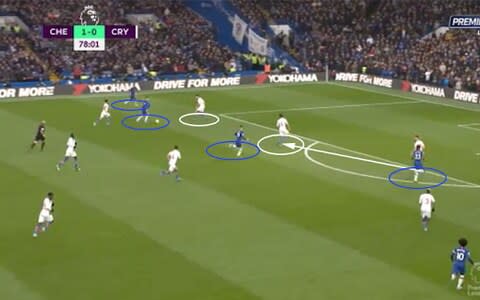
The ball is sent into the area and Batshuayi controls it. Palace’s defence has been pulled apart and scurries to get into a solid line.
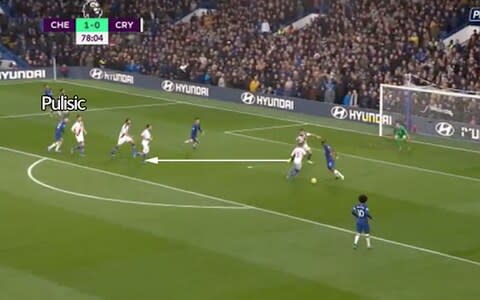
Pulisic reads the play though and ghosts in behind the Palace defenders, whose attention has turned to the ball and the threat of Batshuayi…
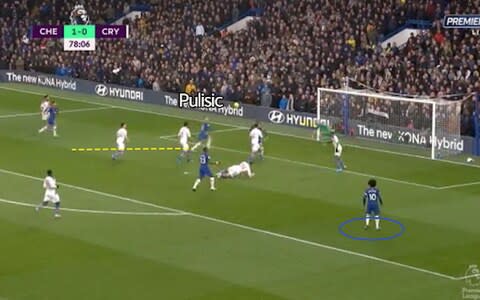
And this allows him to arrive in space inside the six yard box to head past the goalkeeper. Willian has stayed wider on the right to offer another option in space and keep the Palace left-back away from the centre-backs.
"One can always hope you can meet an opponent who’s a bit jaded or not playing to their full potential," Hodgson said after the match. "We weathered the early storm well, the shape of the team [was good], the players worked hard to control an opponent in great form. I have no criticism of them in any shape or form."
Chelsea are great fun to watch when they flow forward like this but whether it will work against teams like Liverpool and Manchester City, their next opponent, is another matter. City will be wise to the wide overloads and built to hit Chelsea in transition, just as Manchester United did at the start of the season, and it could lead to an end-to-end goalfest or a pummelling for Lampard’s side.
It’s a high risk, high reward strategy but at the moment few teams can cope with Chelsea’s attacking might.

 Yahoo Sport
Yahoo Sport 





































